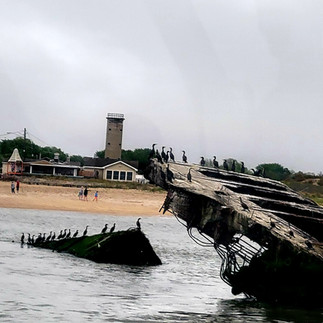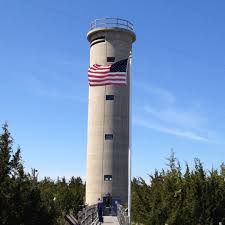
The world was Hugh Callaway’s oyster and indulge he did. A revolving door of ladies kept his calendar occupied. How he kept track of them all was anyone’s guess, but one thing was certain -- none ever stuck around for very long.
Smart-mouthed, strong-willed, and fiercely independent, all Shannon Culligan’s ever known of love is how much it hurts.
When the U.S. enters World War One, Hugh enlists in the Navy. He is soon stationed at Cape May Section Base Number 9, where Shannon just so happens to work at the nearby barracks mess hall.
Meanwhile, the German submarine U-151 is on a deadly mission mining the Delaware Bay.
Will this dashing Lieutenant be able to stop the enemy from terrorizing the offshore shipping lanes? Or end up in a watery grave himself?

*photo credit: Joseph Bilby
Submarine warfare weighs heavily on the mind of my character, Shannon Culligan, from the onset of Thicker Than Water.
Not only is her beloved brother, Danny, out on the water daily as a fisherman, but the man she's slowly starting to fall for is a Naval Lieutenant charged with patrolling the coast.
With regard to historical events in narrative, I tried to stay as close to source material as possible based on my research. A NJ resident myself, making sure the details were accurate was a matter of utmost importance to me from the beginning.
That said, the timeline of events (subsequent to U.S. mobilization) as they play out through the book are as follows based on my research:
December 6, 1917: German U-boat U-53 torpedoes and sinks the U.S. Naval Destroyer Jacob Jones off he coast of Cohb, Ireland.
February 5, 1918: The British Cunard liner Tuscania (now pressed into service as an American troop transport) is the first ship lost. Torpedoed near Northern Ireland, over 200 soldiers and crew perished.
April 1918: The German submarine U-151 departs from Kiel with a mission to attack American East Coast shipping.
Early May 1918:
Based on reports from the British steamships Port Said and Huntress, U-151 is known to have entered U.S. waters. The enemy sub is said to have torpedoed both vessels but missed.
The Navy issued the following instructions to merchant ships, "no lights should be carried, except as may be necessary to avoid collision, and paravanes (utilized for mine-sweeping) should be used when practicable and feasible."
Authorities did not, however, call for dim-out/blackout conditions along the coastal shore communities (as did their European counterparts).
The U-boat initially heads south, to North Carolina, laying mines down the coast close to Currituck Sound.
She then moved north, doing the same off the Chesapeake Bay inlets at Cape Henry and Cape Charles.
U-151 attacks three (3) sailing schooners- the Hattie Dunn, the Hauppauge, and the Edna, in a series of surface-to-board strikes.

*photo credit: Raiders of the Deep
"The officer was so polite that he almost got on our nerves."
Pictured above is Lieutenant Frederick Koerner. The commanding "boarding officer" of the sub. Koerner's manners were described the same time and again by crew members of the Dunn, Hauppauge, and Edna.
His M.O was simple, straightforward, and irritatingly polite- ask the ship's captain for her paperwork, provide receipts (written in German), and order the crews to lifeboats with instructions to row to the U-boat, where they were promptly taken captive so as not to alert authorities.
Koerner's crew would then plant explosives as shown below.

*photo credit: Raiders of the Deep
May 28, 1918: U-151 cuts the telegraph cables to Central America and Europe off the coast of Sandy Hook.
June 2, 1918/ Black Sunday: In total, U-151 sunk six (6) ships off the coast of NJ. These included: Isabel B. Wiley, Winneconne, Jacob M. Haskell, Edward H. Cole, Texel, and Carolina.
June 3, 1918: The oil tanker Herbert L. Platt strikes one of U-151's mines in the Delaware Bay. Rescue teams from both Cape May and Cape Henlopen respond, Evacuees were brought safely to Lewes, DE.
June 4, 1918: The Port of New York is closed to outgoing shipping as a precautionary measure.
Research indicates that U-151 ultimately left U.S. waters in July 1918, but the damage was done. By the time she reached her home port on July 20th, a total of twenty-two (22) ships were sank.
However, this was not the only submarine so brazen as to engage with American civilian ships. On August 13, 1918, U-117 made her first appearance, torpedoing the Frederick R. Kellogg just north of Barnegat. Sadly, seven (7) crew members perished.
Like her predecessor, U-117 also found herself in the waters off Cape May, allowing the crew of the Dorothy B. Barrett to depart in lifeboats before sinking her.
As with all my research materials, I hope readers find A History of Submarine Warfare Along The Jersey Shore as fascinating as I did. For further reading, might I suggest:
The First Resort (Fun, Sun, Fire & War in Cape May, America’s Original Seaside Town) by Ben Miller
US Coast Guard Training Center at Cape May by Joan Berkey and Joseph E. Salvatore, MD
Sadly, the coast came under attack again during the next World War. To those interested learning more about that challenging time, I recommend stopping by the World War II Lookout Tower. Tours can be arranged through Cape May MAC and make for a great activity with the kids.
And as for Hugh and Shannon? You'll have to read TTW to find out what happens next. Pre-order your copy here. And don't forget to add it to your Goodreads.
Next week is Launch Week!!! Hard to believe that, after 2 years of research and another 2 of writing/revising this day is almost here. I hope you'll join me in celebrating. And thanks to all of the followers who've been with me since the beginning of this momentous journey. Let the countdown begin...





コメント